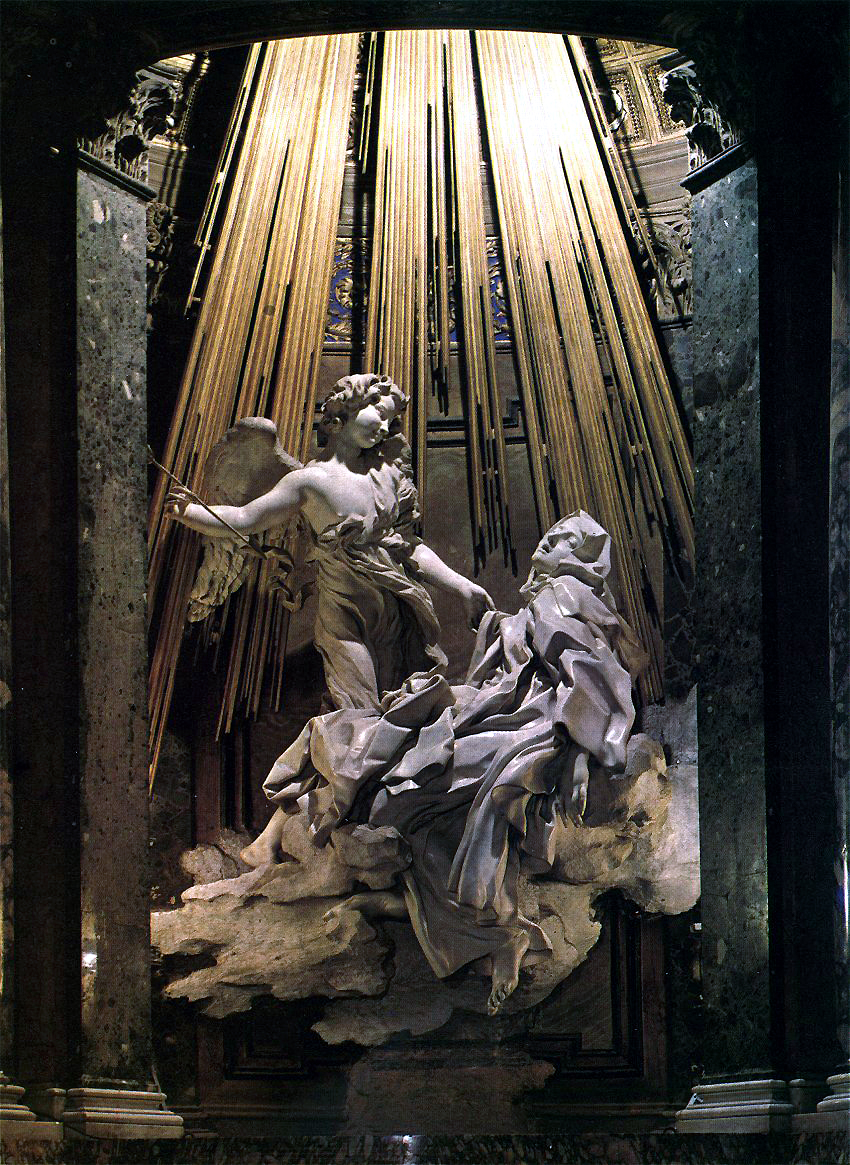Verzückung der Hl. Teresa von Avila, Lorenzo Bernini

L'Estasi di Santa Teresa d'Avila (1647 – 1652)
*

Michelangelo di Buonarroti Simoni (1499)
Pietà
Hart wie ich bin, weiß ich nur Eins:
Du wurdest groß -
.... und wurdest groß,
um als zu großer Schmerz
ganz über meines Herzens Fassung
hinauszustehn.
Jetzt liegst du quer durch meinen Schoß,
jetzt kann ich dich nicht mehr
gebären.
Rainer Maria Rilke
Das Marien-Leben (1912)
vergleiche auch
Palden Lhamo - The Goddess Who Rides on a Sea of Blood

Palden Lhamo is of the major protector deities in Tibetan Buddhism and the
only female among the powerful group of the Eight Dharma Protectors (skr.
Dharmapalas). She is particularly favored by the Gelukpa, for whom she is
a special protector of Lhasa and the Dalai Lama. She was also a protectress of imperial China from the
Yuan dynasty in the thirteenth century to the end of the Qing dynasty in
the twentieth century. In India, Palden Lhamo is also known as Shri Devi.
She is considered a wrathful manifestation of Saraswati, the goddess of
learning, eloquent speech, and music. From the gods she received a mule, whose covering is the
skin of a Yaksha or demon, and the reins are venomous serpents. She is
always shown seated sideways on this mule.
Palden Lhamo is said to have been married to a bloodthirsty warring king who refused all her entreaties to stop his wanton killing. She finally issued an ultimatum: if he wouldn’t stop the killing, she would personally slay their child so the king would experience for himself the pain that his warring caused to others. He did not stop, she carried out her threat, and his loss finally did bring him to a halt. She is thus depicted carrying her dead son’s body with her on her mule, showing that she will stop at nothing to achieve peace. As the goddess mounted a mule (covered with the flayed skin of her son) to flee the kingdom, the king aimed an arrow in her direction, hitting the mule's haunch. Shridevi removed the arrow and magically transformed the wound into an eye, thus augmenting her powers to see and watch over the realms of the Buddhist faith.
The mule she is riding upon gallops furiously over a sea of blood. She is largely naked and adorned with a necklace made up of freshly severed heads. From her saddle hangs a pouch with dice. Indeed her initiation is held to be a gateway to divinatory powers, and she can be invoked by practitioners of the Tibetan system of divination known as mo, which involves the use of dice. There is also a lake calle Lhamo Latso, to the south-east of Lhasa, whose reflections are said to reveal the future.
Die Palden Lhamo (tibetisch: dPal dan lha mo;
Sanskrit: Shri Devi) ist eine der bedeutendsten Schutzgottheiten im
tibetischen Buddhismus und die einzige weibliche Gottheit in der mächtigen
Gruppe der acht Dharma-Beschützer (dharma-palas). Sie wird besonders von
den Gelugpas verehrt, für die sie eine besondere Schutzgottheit Lhasas und
des Dalai Lama ist. Man weiß, daß sie an einem geheimnisvollen See, dem
Lhamo Latso, ca. 145 km südöstlich von Lhasa, erscheint. Dieser See ist
dafür bekannt, daß er an seiner Oberfläche die Spiegelbilder der Zukunft
offenbart. Der 2. Dalai Lama Gendün Gyatso (1475-1542) gründete hier 1509
das Kloster Choekorgyal. Seit dieser Zeit war es bei den Dalai Lamas
Brauch, dem Kloster und dem magischen See jedes Jahr einen Besuch
abzustatten.
Palden Lhamo als Shri Devi repräsentiert die dunklen Kräfte des Großen Mutter-Aspektes im Leben. Im Buddhismus ergriff sie eine beschützende Machtfunktion, um die zerstörerischen Kräfte der Ich-Bezogenheit zu bezwingen. Speziell in Tibet könnte sie alte einheimische, mit der Boen-Tradition verbundene weibliche Gottheiten verdrängt haben.
The Lament for Icarus, Herbert Draper, 1898, Tate Gallery